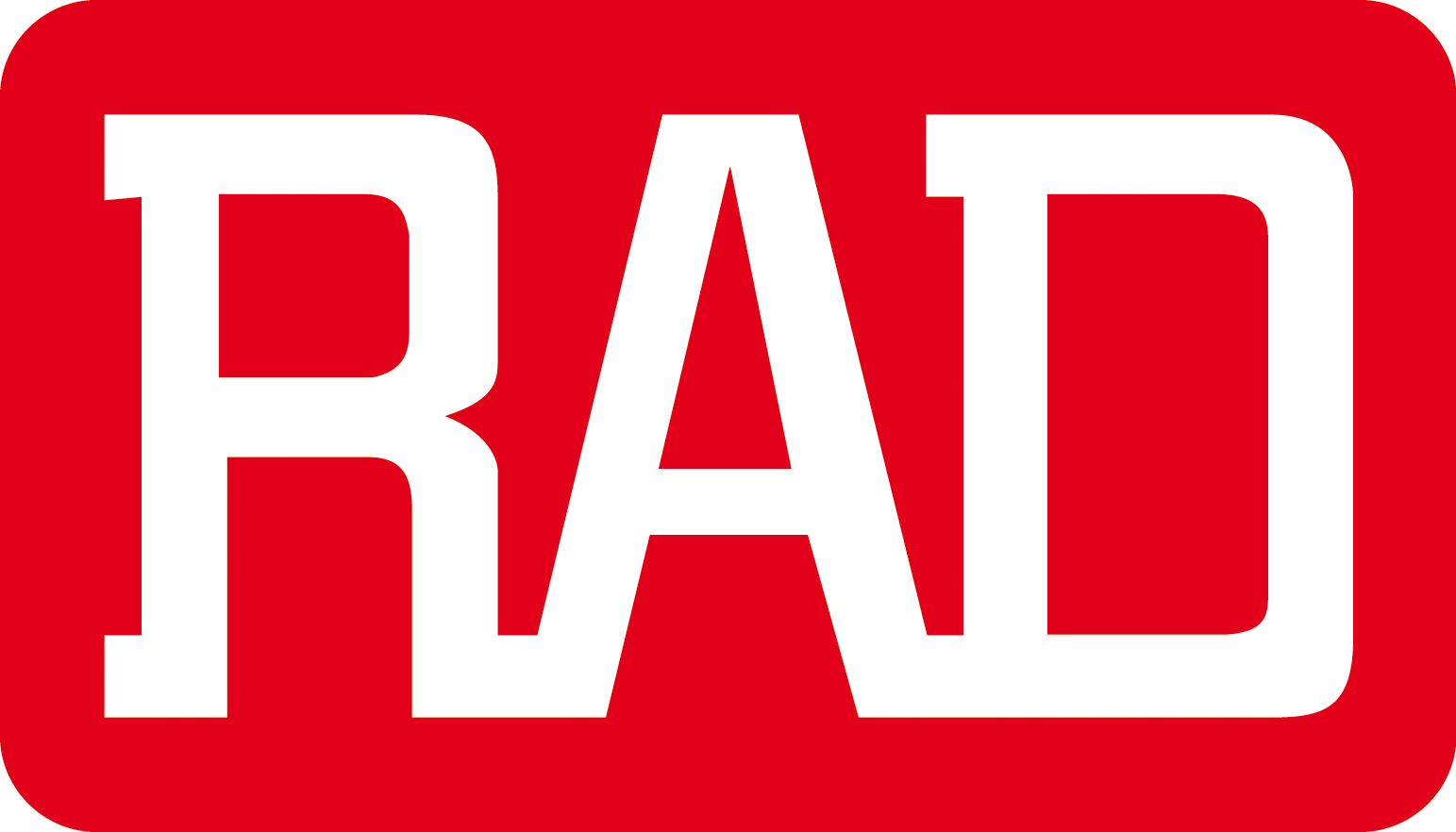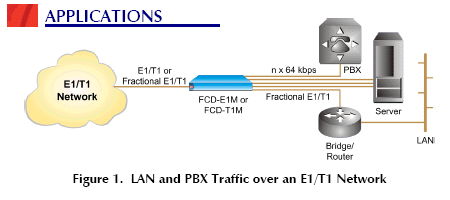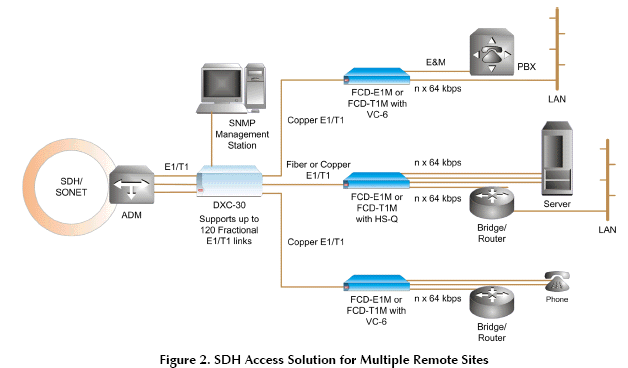




FCD-T1M and FCD-E1M modular T1/E1 unit from RAD
FCD-T1M and FCD-E1M from RAD serve as access multiplexers, to provide business customers with modular integration of voice and data traffic over E1 / T1 or Fractional E1 / T1 services (see Figure 1). The FCD-E1M and FCD-T1M also operate opposite RAD's modular DXC multiservice access node or other vendors' E1 / T1 equipment, for multilink star applications, such as access to SDH networks. The RAD DXC and FCD units operate together with centralized SNMP network management (see Figure 2).

The FCD-T1M and FCD-E1M can be ordered with a copper E1/T1 or a fiber optic link. Both configurations are also available with an optional copper sub-E1 drop-and-insert port. The units include a single data port, or an Ethernet bridge with or without VLAN support, or an Ethernet router. FCD-E1M and FCD-T1M include a single I/O module slot that supports one Megaplex I/O module. This provides field upgrade and service profile change capabilities that are usually available only on larger modular devices. For supported
module details and ordering information, see individual module data sheets.

The basic FCD-T1M or FCD-E1M contain a power supply, a copper E1/T1 link, one data port, and single a slot for a Megaplex-2100 I/O module. The sublink and Ethernet bridge/router are optional.
The E1 interface of the FCD-E1M is compatible with most carrier-provided E1 services and meets ITU recommendations G.703, G.704, G.706, and G.732. The E1 interface supports either 2 or 16 frames per multiframe, with or without CRC-4. The main link also operates in unframed mode to generate an unframed signal. Line code is HDB3. The integral LTU (soft-selectable) ensures a range of up to 2 km (1.2 miles).
The T1 interface of the FCD-T1M is compatible with most carrier-provided T1 services and complies with TR-62421. The T1 interface supports D4 and ESF framed formats. The main link operates in unframed mode to generate an unframed signal. Zero suppression over the line is selectable for either transparent, B7ZS, or B8ZS. The integral soft-selectable CSU ensures a range of up to one mile.

FCD-E1M and FCD-T1M can be ordered with a fiber optic main link to eliminate the need for an external fiber optic modem. The fiber optic link provides a secure link in hazardous or hostile environments with greater range. It complies with ITU standards G.921 and G.956.
Three fiber optic interfaces are available:
850 nm laser for use over multimode fiber at distances of up to 5 km (3 miles)
1310 nm laser diode for use over single-mode fiber at distances of up to 62 km (38 miles)
1550 nm laser diode for use over single-mode fiber at extended range of up to 100 km (62 miles).
Timeslot assignment is programmable to allow data from each data port and from the sublink to be placed either automatically into consecutive timeslots, or manually, according to user discretion. Multiple clock source selection ensures maximum flexibility for supporting different applications. The E1 main link may derive its timing from the recovered receive clock, from an internal oscillator, from one of the data ports, or from the sub-E1 port. Bypassing the sublink to the main link (other than fiber optic) ensures uninterrupted service to the sub- E1 / T1 port and provides immunity to hardware and power failure.
FCD-E1M and FCD-T1M are standalone units. A rack mount adapter kit allows installation of one unit in a 19-inch rack.
FCD-E1M and FCD-T1M User Interface
The following data port interfaces can be ordered: V.35, RS-530, V.36/RS-449, or X.21. The ports operate in the following clock
modes:
DCE: The FCD units provide the transmit and receive clocks to the user equipment, with an option to sample the incoming data with an inverted clock
DTE1: The external transmit clock is taken from the user DTE
DTE2: Both the transmit and receive clocks are taken from the user DTE.
When equipped with IR-ETH or IR-ETH/Q bridge options, RAD FCD-E1M and FCD-T1M transparently connect remote LANs over unframed E1 / T1 links to utilize the full E1 / T1bandwidth. The bridges filter Ethernet frames and forward only frames destined to the WAN. The IR-ETH/Q bridge also supports VLANs. The optional built-in Ethernet router is a high-performance remote IP router. It is ideal as a LAN extender or segmenter over bit-stream type infrastructures. The router receives Ethernet packets from the LAN and forwards them to the IP network on the Ethernet LAN or to the WAN by destination.
The optional sub-E1 port can be configured to work without CRC-4, while the E1 main link works with CRC-4. This enables non-CRC-4 equipment to connect to a CRC-4 E1 network.
The optional sub-T1 port can be configured with D4 or ESF framing, while the T1 main link uses ESF
framing. This allows connection of T1 D4 equipment over a T1 network.
FCD-T1M and FCD-E1M Management and Maintenance
Setup, control and monitoring of status and diagnostics information can be activated via:
ASCII terminal connected to the async control port command line interpreter
SNMP management connected to the async control port.
FCD-E1M and FCD-T1M have an internal SNMP agent and can be controlled by any generic SNMP station or by the GUI-based RADview SNMP network management application.
FCD-E1M and FCD-T1M support dial-in and dial-out modem connections. These connections can be used for remote out-of-band configuration, monitoring and for sending callout alarm messages using serial V.24 SLIP, PPP, or Ethernet ports.
Inband management on the FCD-E1M can be performed by using the spare bits (Sa bits) on TS 0 or by using a dedicated timeslot using standard protocols, Frame Relay (RFC 1490), PPP, and standard RIP2 routing. This allows setup, monitoring and diagnostics of the remote unit. Inband access using spare bits on TS 0 is possible only if those bits are transparently passed end-to-end.
Inband management on the FCD-T1M can be performed by using the Facility Data Link (FDL) in the ESF framing format or by using a dedicated timeslot. This allows setup, monitoring and diagnostics of the remote unit. Inband access using the FDL is possible only if the FDL is transparently passed end-to-end.
Maintenance capabilities include user-activated local and remote loopbacks on the E1/T1 main link, sub-E1/T1, and data ports. The user can activate a BER test for each data or sub-E1/T1 port, individually. Each data or sub-E1/T1 port responds to an ANSI FT1 RDL (T1E1.2/93-003) inband loop code, generated by the remote FCD-E1M/FCD-T1M, DXC, or dedicated test equipment in a specific bundle of timeslots allocated only to that port. In addition, FCD-T1M responds to network activated loops (PLB, LLB) when configured as CSU.
When operating with CRC-4, E1 network statistics are stored in memory according to RFC-1406. Statistical information may be
retrieved locally through the control port.
When operating in the ESF format, T1 network statistics are stored in memory according to ANSI and AT&T standards. Statistical information may be retrieved by the service provider (ANSI only) or locally through the control port.

FCD-E1M and FCD-T1M product data sheet (pdf)